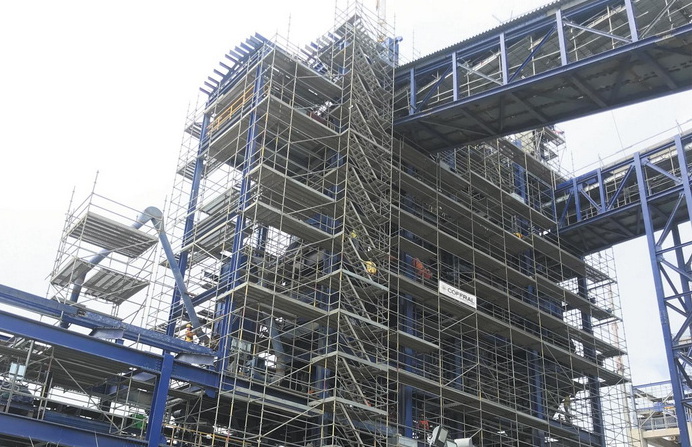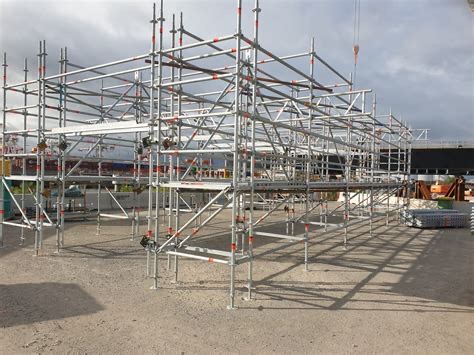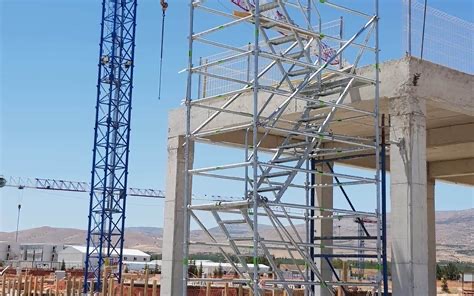Content Menu
● Defining the APS Unit Scaffolding System
● Key Advantages of APS Unit Scaffolding System Over Traditional Methods
>> 1. Enhanced Safety
>> 2. Increased Efficiency and Productivity
>> 3. Versatility and Adaptability
>> 4. Cost-Effectiveness
>> 5. Enhanced Load-Bearing Capacity
>> 6. Reduced Material Waste
>> 7. Easier Transportation and Storage
● Applications of the APS Unit Scaffolding System
● Case Studies: Real-World Examples of APS Unit Scaffolding System in Action
>> 1. High-Rise Construction in Chicago
>> 2. Bridge Maintenance in San Francisco
>> 3. Industrial Plant Renovation in Houston
● Addressing Common Concerns About APS Unit Scaffolding Systems
● Conclusion
● FAQ
>> 1. How does the APS Unit Scaffolding System enhance safety compared to traditional scaffolding?
>> 2. What types of projects are best suited for the APS Unit Scaffolding System?
>> 3. Can the APS Unit Scaffolding System be easily adapted to different heights and configurations?
>> 4. What maintenance is required for the APS Unit Scaffolding System?
>> 5. Is special training required to assemble and use the APS Unit Scaffolding System?
● Citations:
In the construction, maintenance, and renovation industries, scaffolding systems play a pivotal role in providing safe and efficient access to elevated areas. While traditional scaffolding methods have been around for decades, the advent of advanced systems like the APS Unit Scaffolding System has revolutionized the way work-at-height tasks are approached. The APS Unit Scaffolding System offers a multitude of advantages over traditional methods, ranging from enhanced safety features to increased productivity and cost-effectiveness. This article delves into the specific advantages that make the APS Unit Scaffolding System a superior choice for modern projects.

Defining the APS Unit Scaffolding System
The APS Unit Scaffolding System is a modular scaffolding solution engineered to provide a safe, efficient, and versatile working platform. Its key characteristics include:
- Unitized Design: Pre-engineered units allow for quick and straightforward assembly.
- Integrated Safety Features: Enhanced safety through built-in guardrails, toe boards, and secure locking mechanisms.
- Versatility: Adaptable to a wide range of project requirements and complex geometries.
- High Strength-to-Weight Ratio: Lightweight yet robust construction ensures stability and load-bearing capacity.
- Reduced Labor Costs: Faster assembly and dismantling minimize labor expenses.
The APS Unit Scaffolding System stands out from traditional scaffolding by offering a more streamlined, secure, and adaptable solution that meets the demands of modern construction and maintenance projects.
Key Advantages of APS Unit Scaffolding System Over Traditional Methods
1. Enhanced Safety
Safety is a paramount concern in any construction or maintenance project, and the APS Unit Scaffolding System significantly enhances worker safety compared to traditional methods. Traditional scaffolding often relies on makeshift or less reliable safety measures, increasing the risk of accidents and injuries.
The APS Unit Scaffolding System, on the other hand, incorporates integrated safety features such as:
- Guardrails: Preventing falls from elevated platforms.
- Toe Boards: Preventing tools and materials from falling off the scaffolding.
- Non-Slip Platforms: Providing secure footing for workers.
- Secure Locking Mechanisms: Ensuring stable and reliable connections between components.
These integrated safety features minimize the risk of accidents and create a safer working environment for construction and maintenance personnel.
2. Increased Efficiency and Productivity
The APS Unit Scaffolding System is designed for quick and easy assembly and dismantling, reducing labor costs and project timelines. Traditional scaffolding methods, such as tube and clamp scaffolding, can be time-consuming and require specialized skills to erect and dismantle.
The unitized design of the APS system allows for faster assembly with minimal training. The pre-engineered units fit together seamlessly, reducing the need for cutting, welding, or other time-consuming modifications.
This increased efficiency translates into higher productivity and reduced overall project costs.
3. Versatility and Adaptability
The APS Unit Scaffolding System is highly versatile and can be adapted to a wide range of project requirements and complex geometries. Traditional scaffolding methods often struggle to accommodate irregular shapes, varying heights, and confined spaces.
The modular design of the APS system allows for flexible configurations, making it easy to adjust the scaffolding to fit specific project needs. The system can be easily adapted to accommodate curves, angles, and other architectural features.
This versatility makes the APS Unit Scaffolding System suitable for a wide range of applications, from high-rise construction to bridge maintenance and industrial repairs.
4. Cost-Effectiveness
While the initial investment in an APS Unit Scaffolding System may be higher than traditional scaffolding methods, the long-term cost savings can be significant. The APS system reduces labor costs, minimizes maintenance expenses, and improves project efficiency, resulting in a lower overall cost of ownership.
The reduced labor costs associated with faster assembly and dismantling are a major factor in the cost-effectiveness of the APS Unit Scaffolding System. The system also requires less maintenance than traditional scaffolding, as its durable components are designed to withstand the rigors of the construction environment.
5. Enhanced Load-Bearing Capacity
The APS Unit Scaffolding System is engineered to provide a high load-bearing capacity, ensuring a safe and stable platform for workers, tools, and materials. Traditional scaffolding methods often have limitations in terms of the weight they can safely support.
The APS system utilizes high-strength materials and robust construction techniques to achieve a superior load-bearing capacity. This makes it suitable for heavy-duty applications, such as supporting concrete forms, machinery, and other heavy equipment.
6. Reduced Material Waste
The modular design of the APS Unit Scaffolding System minimizes material waste compared to traditional scaffolding methods. With traditional tube and clamp scaffolding, materials often need to be cut to size, resulting in wasted pieces and increased disposal costs.
The pre-engineered units of the APS system fit together seamlessly, reducing the need for cutting or modification. This minimizes material waste and promotes sustainable construction practices.
7. Easier Transportation and Storage
The APS Unit Scaffolding System is designed for easy transportation and storage. The system's modular components can be easily stacked and transported to the job site, reducing transportation costs and logistical challenges.
Traditional scaffolding methods often require more space for storage and transportation due to their bulky and irregular shapes. The compact and stackable design of the APS system makes it easier to manage and store, both on and off the job site.

Applications of the APS Unit Scaffolding System
The APS Unit Scaffolding System is used in a wide range of applications across various industries:
- High-Rise Construction: Providing safe and efficient access for building construction, facade installation, and window cleaning.
- Bridge Maintenance: Facilitating repairs, inspections, and painting on bridges and overpasses.
- Industrial Plants: Offering a stable platform for maintenance and repair work in factories, refineries, and power plants.
- Shipbuilding: Providing access for welding, painting, and other tasks in shipyards.
- Event Staging: Creating elevated platforms for concerts, festivals, and other events.
- Renovation Projects: Allowing workers to safely access facades, roofs, and interiors during renovation projects.
Case Studies: Real-World Examples of APS Unit Scaffolding System in Action
1. High-Rise Construction in Chicago
In the construction of a 60-story office tower in Chicago, the APS Unit Scaffolding System was used to provide access for facade installation. The system's high load-bearing capacity and wind resistance allowed workers to safely and efficiently complete the project, despite challenging weather conditions.
2. Bridge Maintenance in San Francisco
The APS Unit Scaffolding System was used to facilitate repairs on the Golden Gate Bridge in San Francisco. The system's versatility and adaptability allowed workers to access difficult-to-reach areas and complete the project on time and within budget.
3. Industrial Plant Renovation in Houston
An APS Unit Scaffolding System was deployed for the renovation of a chemical processing plant in Houston. The system's chemical resistance and safety features were critical in ensuring worker safety in the corrosive environment.
Addressing Common Concerns About APS Unit Scaffolding Systems
While APS Unit Scaffolding Systems offer many advantages, there are a few common concerns that are often raised:
- Initial Cost: The initial cost of an APS system can be higher than traditional scaffolding. However, the long-term cost savings from reduced labor, waste, and maintenance typically outweigh the initial investment.
- Training: Proper training is essential for the safe and efficient use of an APS system. However, the training requirements are generally less extensive than those for traditional scaffolding methods.
- Complexity: Some workers may initially find the APS system more complex than traditional scaffolding. However, the system's unitized design and straightforward assembly process make it easy to learn and use.
Conclusion
The APS Unit Scaffolding System offers numerous advantages over traditional scaffolding methods, including enhanced safety, increased efficiency, versatility, cost-effectiveness, and reduced material waste. Its unitized design, integrated safety features, and adaptability make it a superior choice for modern construction, maintenance, and renovation projects. By investing in an APS Unit Scaffolding System, companies can improve project outcomes, reduce costs, and create a safer working environment for their personnel.

FAQ
1. How does the APS Unit Scaffolding System enhance safety compared to traditional scaffolding?
The APS Unit Scaffolding System enhances safety through integrated safety features such as guardrails, toe boards, non-slip platforms, and secure locking mechanisms. These elements provide a safer working environment and minimize the risk of accidents.
2. What types of projects are best suited for the APS Unit Scaffolding System?
The APS Unit Scaffolding System is versatile and can be used in a variety of projects, including high-rise construction, bridge maintenance, industrial plant renovation, and event staging. Its adaptability makes it suitable for both small and large-scale operations.
3. Can the APS Unit Scaffolding System be easily adapted to different heights and configurations?
Yes, the APS Unit Scaffolding System is designed for maximum adaptability. The modular components allow for easy adjustments to different heights and configurations, making it simple to customize the scaffolding to fit the specific requirements of your project.
4. What maintenance is required for the APS Unit Scaffolding System?
To ensure the longevity and safety of the APS Unit Scaffolding System, regular maintenance is essential. This includes inspecting all components for signs of wear, rust, or damage before each use. Cleaning the scaffolding after each project helps prevent corrosion and ensures smooth operation.
5. Is special training required to assemble and use the APS Unit Scaffolding System?
While the APS Unit Scaffolding System is designed for easy assembly, proper training is recommended to ensure safe and correct setup. Training should cover the assembly process, safety protocols, and load capacity limits to minimize the risk of accidents and ensure the system is used effectively.
Citations:
[1] https://pplx-res.cloudinary.com/image/upload/v1740571215/user_uploads/CeSuPcovqtdMSCe/image.jpg
[2] https://pplx-res.cloudinary.com/image/upload/v1740571215/user_uploads/rblRsdJYvqCaenH/image.jpg






















